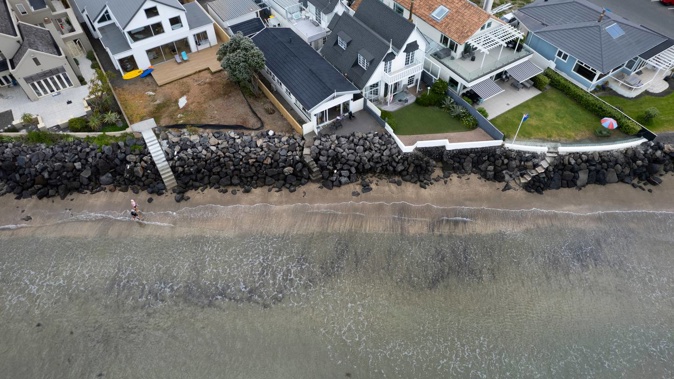
River and surface flooding may pose an even bigger threat to our banks' mortgage portfolios than that direct from the sea, a Reserve Bank analysis reveals.
Results from preliminary climate-related "stress-testing" - and part of a wider RBNZ report being released tomorrow – found more that, in one severe scenario, a quarter of surveyed banks' current Auckland mortgage lending was on land that could be impacted by flooding.
The risk to banks from coastal flooding was also significant, and concentrated in certain regions like Wellington and Christchurch.
The analysis comes amid pre-emptive moves against a rising climate risk in the insurance sector, with one major player recently bringing in risk-based pricing for flood-exposed properties and developing a new model for coastal impacts.
But banks are in the firing line, too: and given more than 60 per cent of the four largest banks' loan portfolios are made up of housing loans, even a relatively small proportion of stranded assets could threaten financial stability.
In the latest modelling, RBNZ researchers asked banks to measure the exposure in their mortgage portfolios to flood zones under varying levels of sea level rise ranging from 20cm to one metre – a range consistent with IPCC projections from 2040 to 2100.
Coastal flood zones were defined as an area exposed to a one-in-100-year storm tide event - or where there was a one per cent chance in a given year of storm surge and higher tides combining to cause flooding.
The results found there were major differences in the share of mortgage lending on properties that lie within a coastal flood zone across different regions.
According to bank submissions, for 50cm of sea level rise, the largest share of national lending at risk was in Christchurch, accounting for 22 per cent of the national total.
This was followed by Wellington, with 14 per cent of the national total.
- NZ's oceans, marine life at risk - report
- Climate change: risk of 'tropical' distant future for NZ
- BusinessDesk conducts five part study on NZ climate change policy
Hawke's Bay was also at risk, with 15 per cent of mortgage lending in the region's flood zone for 50 centimetres of sea level rise, and almost 20 per cent for one metre of sea level rise.
At the other extreme, in Auckland, just under one per cent of mortgage lending was within a flood zone for one metre of sea level rise.
Yet, when the researchers instead focused the risk from river and surface flooding, more than a quarter of banks' lending fell within the zone.
That was equivalent to around 12 per cent of their total mortgage lending at a national level, under a severe climate change outcome.
Although there was some variability in banks' approaches, most results included a conservative assumption that a property was at risk if any part of the land area touched the flood zone.
Across the participating banks, about 2.5 per cent of mortgaged properties nationwide were exposed to the flood zone with 50cm of sea level rise.
That increased to 3.8 per cent in a more severe climate outcome with one metre of sea level rise – similar to recent Niwa-led work that estimated how around 2.9 per cent of the population, and 3.5 per cent of all buildings, were located in the 50cm flood zone.
A RBNZ summary of the assessment noted how this rising risk could hit property values over time.
New mortgages typically had a maximum 30-year term, and on average a mortgage's principal would be paid down over a shorter time horizon.
"This means that, through gaining a deeper understanding of the likelihood and extent of future flooding risks, banks can position themselves to avoid being exposed to these risks over time — for example by tightening lending requirements in high-risk flood zones," the summary said.
"It also gives banks an opportunity to work with existing customers to manage and mitigate risk."
Importantly for banks, 80 per cent of current mortgages in the identified flood zones had loan-to-value ratios (LVRs) below 60 per cent.
A low LVR meant the mortgage borrower had a large amount of equity to absorb a decline in property value, if this were to occur faster than the remaining term of the loan.
While falls in the value of properties securing mortgages didn't lead to losses for banks alone, with less security a supporting a loan, a bank would be more exposed to loss in the event that a borrower defaulted.
RBNZ deputy governor Christian Hawkesby said the Reserve Bank's long-term aim was to help banks build capability to identify climate risks, which would lead to more "proactive management".
"Although the exercise was far from exhaustive, it provided helpful estimates of exposures to selected climate hazards," Hawkesby said.
"We will use these findings to help build a picture of system-wide risk and to design further climate-related stress testing activities."
Otago University's Associate Professor Ivan Diaz-Rainey said that, as much of the country's wealth – and many of banks' assets – were concentrated in domestic real estate, knowing the potential risk from climate change was critical.
"Most of us live relatively close to the coast, and you don't necessarily need to be living in a low-lying area to be exposed to flooding," he said.
"You add this on top of impacts we're seeing around the world – and here in places like Westport, where supposedly one-in-100-year events are happening two or three times a year – and it makes an awful lot of sense to be looking at this."
Diaz-Rainey is exploring the threat himself, in a Marsden Fund-supported study that involves developing new models to test property impacts against.
He expected the climate threat would hit properties and banks with both quick shocks, like those caused by Canterbury's earthquakes, but also gradual impacts, as seen with the slow build-up to a leaky homes crisis that ultimately cost $47b.
Models already indicated that houses were expected to sell for discounts in areas with higher risks of damage from natural disaster, such as flooding.
That lower price compensated for the higher costs of insurance and repair.
One analysis suggested that, in areas with a one-in-100-year flood risk, the average steady-state sale price discount was about 4.6 per cent.
That of course changed as the return period for flooding narrowed eventually to the point where homes were being permanently inundated.
The current average holding period of a New Zealand house was about 7.4 years - but those homes imminently threatened with permanent flooding were likely to become stranded assets more quickly than that period.
In all, rough estimates have put the cost of losing properties and assets in coastal and floodplain areas threatened by climate impacts at about $145 billion.
Researchers have warned that homeowners living in seaside areas at risk of one-in-100-year flood events today could lose insurance within their lifetimes – and perhaps within the next 10 years.
Over the longer term, insurance retreat from some locations was seen as inevitable.
Take your Radio, Podcasts and Music with you









